173 CD / Ludwig van Beethoven: Piano Sonatas op. 31,1+2 & op. 53
Description
„"Very old - and yet completely new! Beethoven sonatas once again? Yes, once again. For the Austrian pianist Markus Schirmer really has something to say to Beethoven. (…) The way Schirmer illuminates the text (…) and places emphasis on certain aspects is very fresh and personal. A must? - Yes, a must!" (Wiener Zeitung)
14 reviews for 173 CD / Ludwig van Beethoven: Piano Sonatas op. 31,1+2 & op. 53
You must be logged in to post a review.

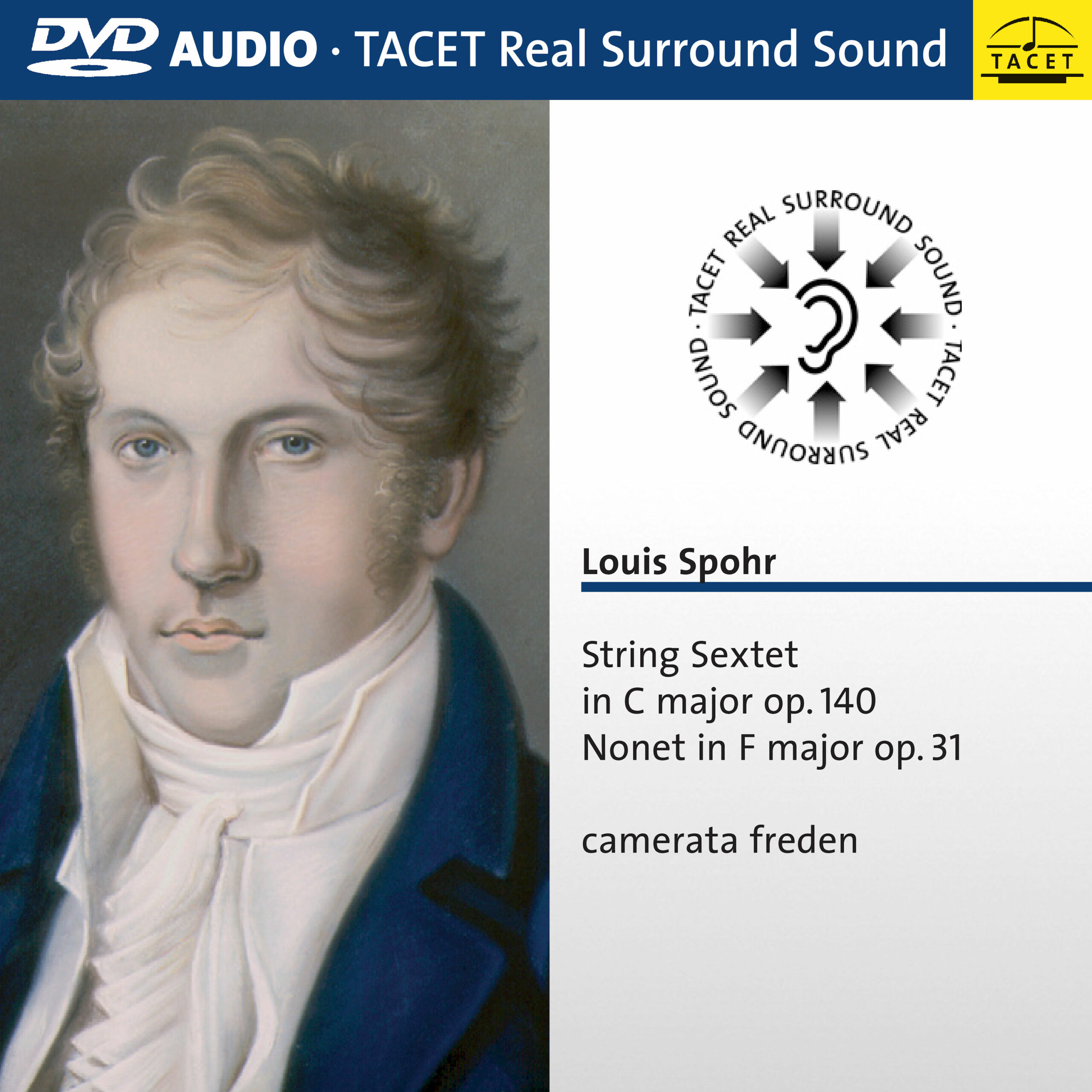


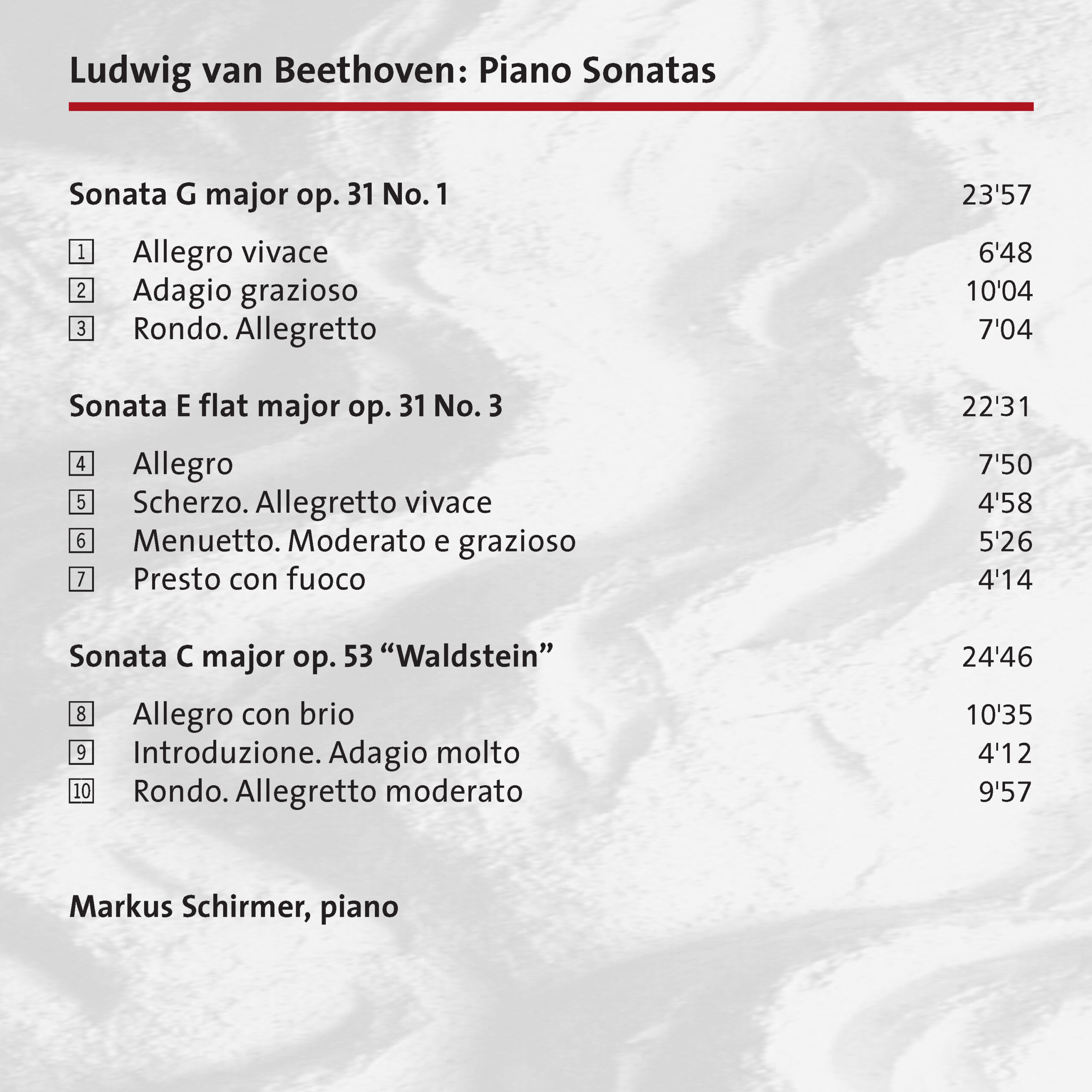


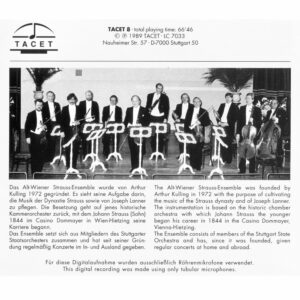




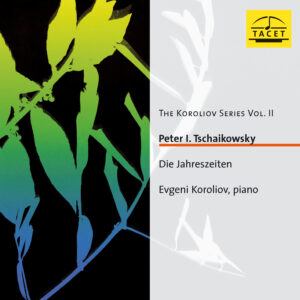
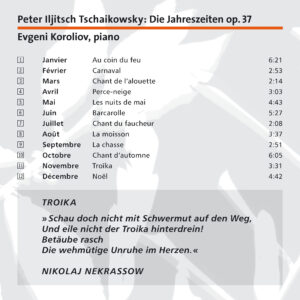
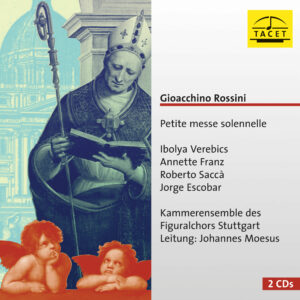
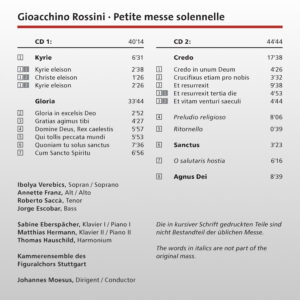


Pizzicato –
Hats off!
"Still more new recordings of Beethoven's piano sonatas," some might say, especially after the recent completions of two cycles by András Schiff and Gerhard Oppitz. However, anyone who has not yet encountered the Austrian pianist Markus Schirmer should consider it a must to do so, and what better way than by listening to this outstanding CD with three piano sonatas from the middle period of the master. This recording truly stands out, not only in its interpretative brilliance but also in its sound quality: Every nuance that Schirmer coaxes from his Fazioli piano is captured in exquisite detail.
The centerpiece of Schirmer's program is, of course, the Waldstein Sonata. The opening movement, this truly formidable challenge, is rarely heard with such brilliance, but also intelligence, and, despite all the motoric energy, such sensitivity as it is here. And then there's the final movement of this sonata, with its masterful development and expansion! It is just as captivating as the swirling conclusion of the E-flat major Sonata Op. 31/3, where the listener, as always with Schirmer, gains the clearest insight into the structures. It is not the astonishing and admirable technical virtuosity, but rather the thoughtfulness and superiority of the concept and its execution that impress the most. Markus Schirmer is a pianist who truly has something to say and, without trying to claim Beethoven for himself, makes it clear to the listener that there is still much, no, still so much to discover. With such skill, intelligence, and sensitivity, one can only say: Hats off!
GW
Fanfare-Magazin –
As nearly as some cursory Web sleuthing could determine, the Austrian pianist Markus Schirmer has concertized little in the U.S., and his recordings (e.g., Schubert sonatas, Lotus 9414; Haydn sonatas, Lotus 9517; Beethoven sonatas, Tacet 128) have not been widely distributed here. He has, nevertheless, appeared with a number of important European orchestras and conductors. He also composes, devotes considerable energies to both chamber music and interdisciplinary performances, and is professor of piano at the conservatory in his native Graz. None of this prepared me for what I was to hear on his latest disc of the first and third sonatas from Beethoven’s op. 31, along with the “Waldstein,” played on an exquisite sounding Fazioli.
Schirmer strikes me as an artist of discriminating taste, intelligence, and tremendous imagination. As a pianist he is fearlessly audacious. His technique is flawless and perfectly attuned to his probative musicality. Listening to Schirmer play, awareness of physical concerns evaporates; one only hears an unimpeded flow of music. The quieter end of his dynamic range on the instrument seems to have dozens of degrees. In fact, it is almost entirely within a normal conversational “tone of voice” that Schirmer enunciates Beethoven’s discourse. This is not to suggest that his playing is in any way understated or introverted, but that the gradations of Schirmer’s dynamic palette from pianissimo to mezzo forte are so numerous and varied that when a sforzato or full fortissimo crops up, the instrument fairly roars. Nothing is ever over-played and even some of the most danger-fraught passages in the “Waldstein” sound effortless. Schirmer also commands a huge arsenal of attack and release strategies—the bustling Allegretto vivace of the famous Scherzo of No. 18 is a veritable tour de force of varieties of staccato and detaché playing. He has what might be described as a finely honed narrative gift, which allows him to move logically and inevitably through Beethoven’s musical arguments, elucidating their thornier syntactical idiosyncrasies. These are well known pieces, yet they seem brim full of surprises, and Schirmer’s architectural grasp is such that each movement seems to speed by. The complete opposite of the dour, scowling Beethoven-specialist type, Schirmer is always ready to give the master’s humorous vein its full due. Don’t be surprised if, listening to the opening Allegro vivace of No. 16, you find yourself laughing out loud. My favorite moments of the entire disc occur in the Adagio grazioso of this sonata, with its long trills and elaborate fiorature floating above a staccato accompaniment, perfectly secco as Beethoven indicates, and here played virtually without pedal.
Over the past year, the two Beethoven sonata recordings that have afforded me greatest pleasure are those of Andreas Haefliger in opp. 28 and 57 (Avie 2143) and Ronald Brautigam in opp. 53, 54, 57, 78, 79 (BIS 1573). Schirmer is as unlike either of these as they are unlike one another; yet all three produce strikingly original performances. Schirmer’s Beethoven—played on a fine instrument and beautifully recorded in a flattering space—is clean, vivid, stylish, and never less than thoroughly enjoyable. You may find yourself as eager as I to hear him live stateside, and soon.
Patrick Rucker
Concerti –
“Preserve Mozart’s spirit from Haydn’s hands,” Count Waldstein told Beethoven in 1792 as he set off for Vienna. Twelve years later, the composer demonstrated to his patron with his Waldstein Sonata that he had found his own path, as he had already done shortly before with the Sonatas Op. 31. With eloquence, elegance, and profundity, Markus Schirmer traces the master’s new directions on his second CD featuring Beethoven’s sonatas.
DH
Piano News –
Austrian pianist Markus Schirmer has already recorded Beethoven's early sonatas with Op. 13 and Nos. 2 and 3 of Op. 2. Now, he follows up with three from the middle period. Once again, his playing impresses with its unpretentiousness, thoughtfulness, and the precision of the notes in Beethoven’s music. Above all, one hears Beethoven – and that’s how it should be! Schirmer’s status as a marvelous sound interpreter and brilliant performer does not contradict this, but rather complements it. Schirmer plays a magnificent Beethoven, one that the listener can follow with ease. The occasional wonderful rubato touches and expertly placed accents only enhance this impression. A model Beethoven recording.
Carsten Dürer
Klassik heute –
From his home base in the Styrian city of Graz, pianist Markus Schirmer has been expanding internationally with great success for several years. I have admired him as a pianist since his immensely dynamic and responsive Haydn recordings for the Lotus label, considering him one of the most important Austrian artists. His interests are not limited to conventional piano repertoires but also extend to more unconventional projects. For example, in a production of Mussorgsky's Pictures at an Exhibition, he involved actor Wolfram Berger, who contributed fitting texts by the poet V. Chlebnikov to accompany Schirmer’s piano performance (documented on Tacet).
Now, Schirmer attracts attention with a second Beethoven CD for the highly active producer, who works tirelessly in both the present and the past (Welte-Mignon!), and whose sound production is more than impeccable. An example: In the swirling, Tarantella-like final movement of the E-flat major Sonata Op. 31, No. 3, Schirmer weaves himself into a quiet, almost secretive turbulence. Most of his colleagues, both past and present, draw attention by playing their initially solo-pulsing left hand in a sharp, even clumsy manner, before allowing the right hand to join in with the thematic material on the higher part of the keyboard. Here, Schirmer demonstrates his own unique weighting of the often-played passage, vividly showing how a movement can unfold, how, based on the best (and carefully applied) mechanics, a musical section can feel as though it’s being opened anew.
The first movement of the Waldstein Sonata remains a challenge, as it is all too tempting to interpret the C-major chord repetitions as a precursor to the machine age, and then proceed to rush through the entire movement, disregarding the hidden tenderness within. It is said that Glenn Gould could not make sense of the motoric aspect of this sonata. However, it is proven that it can also be played with more restraint, both in tempo and diction. Claudio Arrau’s first Philips recording serves, in my view, as a captivating example of how the monotonous motif can be infused with life through a conscious exchange – that is, with empathetic rubato. Schirmer now approaches this phase a touch leaner than Arrau, but one cannot accuse him, as so many of his peers, of merely rattling through it casually. His interpretation makes perfect sense in the first attempt at the score, allowing this sonata to unfold organically, with both speed and contemplation, before the listener.
As for the G-major Sonata Op. 31, No. 1, which is often rushed through in a fast tempo at the beginning, Schirmer finds a convincing middle ground between etude-like activity (particularly in the extravagant broken chords) and caution in handling the important main thematic upbeat. Later, in the Biedermeier-like naïveté of the dance-like secondary theme, he maintains a clear and fresh "narration." The more technical passages are executed with dexterity, but also with care and affection.
Enough of the details: Markus Schirmer has produced a Beethoven CD that is shaped by feeling, grounded in intelligence, and technically flawless. I would place it without hesitation on the same level as more recent recordings by the likes of András Schiff or Gerhard Oppitz.
Peter Cossé
Märkische Allgemeine –
Rock with other means
Austrian pianist Markus Schirmer has a particular affection for his countryman Schubert. For his Schubert debut, the 45-year-old Graz native received a "Preis der deutschen Schallplattenkritik" (German Record Critics' Award). However, his current album is dedicated to Beethoven, specifically his middle period, during which the 30-year-old composer found himself in something of an artistic midlife crisis. One result of his desire for innovation was the Waldstein Sonata. The pianist plays the main theme of this radical piece like rock music with other means. He brings such a whipping and electrifying drive to it that the piece would have blown the wig off its dedicatee, Count Waldstein. Schirmer approaches the older sonatas Op. 31 with a cheerful and cheeky attitude, allowing the inheritance of Haydn and Mozart to shine through. This charismatic pianist combines feeling and intellect. One follows his playing as if it were a gripping crime story.
Antje Rößler
Wiener Zeitung –
"Very old - and yet completely new!
Another Beethoven sonata recording? Is that really necessary? Yes, it is. Because Austrian pianist Markus Schirmer truly has something to say about Beethoven. His interpretations are based on a very careful reading of the score – and, contrary to today's trends, avoid pushing things to extremes. In this sense, it follows the good old tradition. But the way Schirmer delves into the score of the sonatas Op. 31/1, Op. 31/3, and Op. 53 ("Waldstein") and places his accents is very personal and fresh. A must? – Yes, a must!
Edwin Baumgartner
NDR Kultur –
He is known as a member of the Gaede Trio and as a piano partner of Danjulo Ishizaka, Renaud Capuçon, and Clemens Hagen. But the Graz-based pianist Markus Schirmer has also made a name for himself as a soloist. For his first CD featuring music by Schubert, one of his dearly loved composers, he received the "Preis der deutschen Schallplattenkritik" (German Record Critics' Award). His subsequent recordings have also garnered international attention and have been awarded prizes. Five years ago, Schirmer released a highly praised Beethoven CD. Now, after a long hiatus, he continues his Beethoven recordings with the middle-period sonatas.
Beethoven was a restless and passionate spirit. Many of his works are characterized by energy and dramatic power. E.T.A. Hoffmann wrote about the Fifth Symphony: "Beethoven's music moves the levers of shudder, fear, and terror, and awakens that longing which is the essence of Romanticism." This stormy spirit is also palpable in the piano sonatas, especially in the middle-period sonatas that Schirmer has chosen for his second Beethoven CD: the Waldstein Sonata with its repetitive, driving character, and two sonatas from Opus 31.
The three sonatas of Opus 31 were not originally conceived by Beethoven as a cohesive cycle and were actually published individually. Surprisingly, Schirmer leaves out the second sonata, the so-called "Storm Sonata." But as surprising as this omission may be, it fits the Beethoven image that the Austrian pianist portrays: He depicts the stormy character, yet avoids any dramatic exaggeration. Schirmer develops the music from within itself. Thus, temperament does not descend into wild fury, and the lyrical passages do not suffocate in overly sweet pathos but maintain their simple beauty.
A great precision characterizes Schirmer’s Beethoven: On the one hand, there is his tonal clarity and well-considered shaping power, which keeps the grand arc in view; on the other hand, his very precise interpretation of the movement indications. Schirmer’s Grazioso is truly graceful and light, a Presto con fuoco is not just fast, but also has real bite. Yet, despite his faithfulness to the text, Schirmer’s interpretations also have the depth that is embedded in Beethoven's music. For example, in the Adagio of the Waldstein Sonata, he captures the inner turmoil and despair of the work. Emotion and intellect, sound and sense of form make these Beethoven recordings, presented by Schirmer on the Fazioli piano, so captivating. One can only hope that we won’t have to wait another five years for the next Beethoven CD from the Graz pianist.
Chantal Nastasi
Frontal –
Schirmer’s Path to Beethoven: Energetic and Passionate
The new Beethoven CD by Markus Schirmer was eagerly handed to me, I rushed home, catapulted the disc into the CD player with high expectations, played the first movement of the Waldstein Sonata; and played it again; and played it again; and...
There is certainly no shortage of interpretations of Beethoven’s sonatas. None of them are truly unsuccessful or even contemptible. The interpretative approaches, however, vary greatly. From very assertive (Rudolf Buchbinder) to more folk-like, without sharp edges or corners (András Schiff). Markus Schirmer takes another interesting path to Beethoven. He pursues this consistently energetically, dynamically, but also always sensually and passionately, step by step, in a way that is easy to follow. It is exhilarating how Schirmer makes each note transparent, revealing everything, without covering up anything or letting it blur with pedal use.
The master interpreter has recorded three sonatas for the new CD production on the German "Tacet" label, with the "Waldstein" Sonata immediately captivating the listener. Schirmer’s technique is precise and crystal clear. This works in perfect harmony with the voluminous, spatially excellent recording. Recorded in the Graz Helmut-List-Halle, the album leaves nothing to be desired in terms of sound quality. This new CD is Schirmer’s second Beethoven offering after his Schubert, Haydn, Mozart, Ravel, and Mussorgsky recordings. His oeuvre is growing, and that is a good thing. It documents the exciting development of an outstanding Austrian musician, who also impresses with his captivating naturalness—both as a person and as an artist. (...)
Heinz M. Fischer
Kronen Zeitung –
The CD with early Beethoven sonatas, which the Graz star pianist Markus Schirmer released five years ago, now finds a much-anticipated continuation. For the Tacet label, Schirmer has now tackled three sonatas that document Beethoven's entry into his middle creative period, characterized by the use of spectacular expressive means. In this phase, the classical models gradually lose their influence on the composer – the sonatas in G major and E-flat major from op. 31, as well as the famous "Waldstein Sonata" in C major op. 53. Markus Schirmer has often performed these works in concerts. He interprets these pieces at a very high level and with precision, where especially the unpretentious honesty with which he approaches the music is captivating. Schirmer consistently prefers rather calm tempos, not dressing the compositions in a glittery virtuoso costume, but developing the music from within itself. The lyrical does not sound sweet or sentimental, and the stormy does not get lost in fury. Of course, there are – especially of the "Waldstein Sonata" – sharper, more fiery, even explosive readings that capture Beethoven's impetuous spirit more directly. However, Markus Schirmer's precision and thoughtfulness, the smooth elegance of his playing, have their own merits. One can only hope that it won't take another five years before Schirmer can record another CD with Beethoven sonatas.
Martin Gasser
Kleine Zeitung –
Pointed, full of energy, and brilliant.
Markus Schirmer is one of those artists who allow an interpretation to mature in concert before capturing it in the studio. This also benefits his recently released second Beethoven CD. His loyal admirers will remember hearing him perform the piano sonatas op. 31/1 and 3 at the "styriarte" festival in 2001, and the "Waldstein" Sonata in 2007. In April 2008, he then recorded them in the ideal acoustics of the Helmut-List-Halle in Graz.
The combination reveals internal connections: The Sonatas Op. 31/1 and Op. 53 exhibit striking analogies in the harmonic progression of the main theme, the third-relatedness of the second theme, and the Rondo cadence.
Pointed and elegant, the Graz virtuoso highlights the playful character of the G major Sonata Op. 31/1, masters the E-flat major Sonata Op. 31/3 with elan and esprit, and performs the "Waldstein Sonata" Op. 53 with brilliant staccatos, presenting it as a powerful virtuoso piece without descending into hollow frenzy.
Ernst Naredi-Rainer
RBB Kulturradio –
Markus Schirmer's approach to Beethoven is indeed refreshing and highly engaging. In his interpretation of the three Beethoven sonatas—Op. 31/1, Op. 31/3, and the "Waldstein" Sonata Op. 53—released by TACET, Schirmer displays a unique sense of calm and depth. His treatment of the "Waldstein" Sonata, particularly the final Rondo Allegretto moderato, is a perfect example of his refined style. Unlike many other pianists who might rush through it, Schirmer allows the music to unfold naturally, respecting the sonata's 19th-century nickname "Aurora." His playing is both elegant and powerful, avoiding any rush or forced expression. For me, this is truly remarkable piano playing, deserving of the highest praise. When I compare it to other renowned pianists like Fazil Say or Michael Korstick, I find Schirmer’s approach far more exceptional.
Michael Stegemann / Karl-Dietrich Gräwe in „Klassik Diskothek“ auf RBB Kulturradio
Ö1 – ORF –
Here’s something delightful: the Graz pianist Markus Schirmer has continued his series of Beethoven’s piano sonatas. The recordings of the early sonatas were awarded the Pasticciopreis, and now the sonatas op. 31 No. 1 and 3, as well as the Waldstein Sonata, have been released. The CD was practically still hot from the pressing plant when I put it on the turntable yesterday. Schirmer has taken on a struggle with the beacons of piano music, making it all the more exciting to ask whether he could draw something unique from them, a task that seems as impossible as trying to extract something new from Friedrich Schiller’s “Bell.” But fortunately, Beethoven is not Schiller, and Markus Schirmer is Markus Schirmer. The lightness and elegance with which he lifts this Western treasure, as though it had no weight, leaves nothing to be desired. Pure enjoyment.
Helmut Jasbar, Ö 1 „Pasticcio“
hifi & records –
The Graz pianist Schirmer is considered Austria's most versatile piano artist: he is successful in classical music, surprisingly authentic in jazz and world music, and more present than ever as a promoter of young talents. After Mussorgsky and Ravel, his second Beethoven CD follows, where Schirmer makes even well-known Beethoven pianists appear unimaginative. His astounding technique serves only to create finely nuanced, perfectly timed statements with great entertainment value. Schirmer’s Beethoven is full of virtuosity: he not only dazzles with his speed, but also with a new kind of swing, such as in op. 31/1, and with humor – the second movement initially flirts coquettishly, but switches moods as quickly as a chameleon changes color. Perfect is Schirmer’s rhythmic pulse in the scherzo of op. 31/3 or op. 53, and the dynamics in the final presto are outstanding. According to TACET sound engineer Spreer, the Fazioli F-278 was meticulously surrounded with microphones in the Graz Helmut-List-Halle. The result is optimal: wonderfully rich sound with expressive peak dynamics, richness of detail, and a sense of space. Enthralling: a continuation is eagerly awaited.
Ludwig Flich